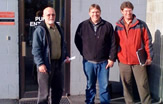Safety Corridor
A Designated Safety Corridor is a segment of a state highway that has been identified as having a higher than average incidence of fatal and serious injury crashes, and the Commissioners of Transportation & Public Facilities and Public Safety have agreed to provide funding for effective education, enforcement, engineers, and support emergency response agencies for those sections of road.
Currently the Seward (May 2006), the Parks (October 2007), the Knik/Goose Bay Road and the Sterling (both in July 2009) are the four designated Safety Corridors in Alaska.
Fatal and major injury crashes are a serious problem in the Safety Corridors. DOT&PF and DPS are tasked by law with the responsibility of reducing these crashes. It is recognized that these roads are at or near traffic volume capacity. Long term, major road projects are needed to address traffic volume growth. In the immediate term, cost-effective solutions will be pursued to reduce severe crashes.
- Fatal and major injury crashes are down by almost 40% overall since May 2006.
- Fatal crashes are up primarily on the Seward Highway. This is a volatile indicator which can vary year to year due to very small numbers. One fatal crash each year makes the difference in whether the trend is up or down, and in 2008 there were two fatal crashes above average.
- The Average Daily Traffic (ADT) numbers are down by 3.5% on the Seward Highway overall, and up by 11% on the Parks Highway.
- Parks Highway severe crash rates are higher than the Seward Highway
Safety Corridors in Other states
Several states, such as California, Washington, and Oregon, have created Safety Corridors with immediate results:
| STATE | DATE INITIATED | PROGRAM DESCRIPTION | PROGRAM IMPACT |
|---|---|---|---|
| California | 1992 | Safety Corridors with increased fines | Collision rates reduced 11% to 37%. Injury collision rates reduced 13% to 47% |
| Washington | 1993 | Safety corridors without increased fines | Collision rate reduced 9% to 40% per corridor |
| Oregon | 2001 | Safety corridors with increased fines | Truck-at-fault collision rate reduced 45% |
Graphs and Tables of Alaska's Safety Corridors
Safety Topics
- DEC / DRE
- Distracted Driving
- Fatality Analysis Reporting System (FARS)
- Headlights
- Media Campaigns
- Occupant Protection
- DUI Information & Impaired Driving
- Senior Driving in Alaska
- Teen Driving in Alaska
- Traffic Records


